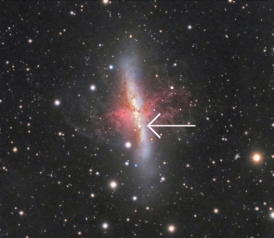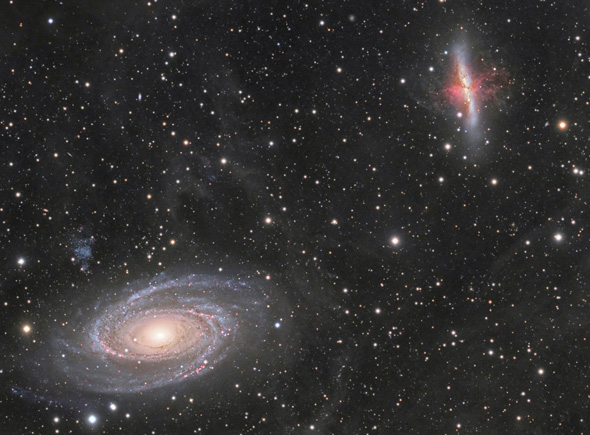A Supernova Punctuates a Galaxy Pair
In a nearby and decidedly odd galaxy, a star exploded. The fierce light and intense energy screamed outward, marching across the vast reaches of space. Vast indeed: It took nearly 12 million years for the light to reach us here on Earth, and by the time it got here the might and power had diminished so much it took a decent-sized telescope to see the results at all.
All across the Earth the news spread of the new supernova. “Amateur” astronomer André van der Hoeven took images, as did his colleagues Neil Fleming and Michael van Doorn. Van der Hoeven combined these photographs to create a portrait of this area of the sky that is stunningly lovely:
What you see here (and yes, do you ever want to see the original larger version) are two galaxies located in the constellation of Ursa Major: the grand spiral M81 to the lower left, and the bizarre and distorted M82 to the upper right. These two galaxies had a close encounter some 300 million years ago, passing each other, and are still close together as seen from Earth.
While M81 is a beautiful tilted spiral, M82 looks … odd. That’s because a few million years ago it underwent a tremendous blast of star formation, one so huge the combined energy from the newborn stars (and the subsequent explosions of the most massive ones when they ended their short lives) is blowing out an enormous wave of gas. You can see the tendrils and filaments eerily wiggling out from the galaxy’s center in the photo.
And in this close-up from that image you can see the new supernova, SN 2014J. It may not look like much, but what you are seeing is the aftermath of one of the largest explosions the Universe can muster. It’s fading now, weeks after the event, but still bright enough to be putting out a significant fraction of the total light of the entire galaxy, which has tens of billions of stars.
When André sent me this photo, it had a large impact on me. In 1993, the light from another supernova reached Earth, but this time it was in M81. At the time, I was studying supernovae for my Ph.D. A friend of mine and I, together with a group of undergrads, went out to the University of Virginia’s one-meter telescope specifically to take a look at the event. I still remember sliding up to the eyepiece, putting my hand over my left eye, and peering through the telescope with my right. The supernova was right there, shining as bright as the core of the galaxy itself. I was moved beyond words. It was the first time I had seen a supernova with my own eyes.

It would be 20 years before I would see another … and that occurred just two weeks ago. I was with another group of friends, people who had traveled to Tucson, Ariz., for a Science Getaways vacation. I had shipped my own Celestron 8” telescope to the ranch we stayed at and was excited when we had clear skies the very first night. I set the ‘scope up in a dimly lit parking lot and we began observing. First up was Jupiter, of course, then the Orion Nebula.
But my gaze kept heading north. Finally, I had to try. Despite never having actually used a small ‘scope to look for M81 and M82, I set about pointing it that way. A little advice from one of the vacationers (using two kitty-corner stars in the bowl of the Big Dipper to point the way) got me in the right area … and suddenly M81 was in my eyepiece. It was a fuzzy blob, but definitely spiral in shape. I took a moment to soak that in, then started fishing around for my real target … and suddenly M82 was right there.
It was amazing, a nearly perfect rectangle shape in the eyepiece, its edge-on appearance making it look linear and squared off. I stared in awe, and let my eyes move up its length slowly, intently searching for the supernova. There was nothing there, but I kept searching, and just before disappointment took hold, POP.
There it was. Just for a moment, in and out, the supernova itself blinked into view and was gone again. I kept at it, watching … and it popped in and out again. I knew what was happening: The sky above us was unsteady, turbulent. Little packets of air act like lenses, distorting the view through the eyepiece. The supernova was just at the edge of visibility, so I could only see it when the air calmed down for a moment, letting the star snap into focus. Just as quickly, the view got blurred again, and the smeared out light was too dim for my eye to see.
It was stunning. Photons from the expanding blast wave of that exploded star had traveled for a dozen million years across the empty reaches of intergalactic space, then for a millisecond through our atmosphere, then a nanosecond through my telescope, to finally fall into my eye and register as a blip of electrical impulse in the neurons of my brain. For a moment, I had made a physical connection with a distant star across the Universe.
Still overwhelmed, I moved aside, and let the guests start to look. One by one they lined up, looked through the eyepiece, and waited. I told them to be patient, and then each in turn gasped or exclaimed or made a noise when it snapped into focus and the distant exploding star became visible. Each of us were able to see it, to let that ancient light tickle our minds.
Shortly thereafter we packed it in for the night. Sadly, it was cloudy the rest of the week, including when we visited my friend Adam Block at the Mt. Lemmon Sky Center, so we didn’t get to look through the big 0.8-meter Schulman Telescope there. I would have dearly loved to see SN 2014J through that equipment; the supernova would have been strong and steady.
But perhaps things worked out for the best. Using my own equipment I was able to find and observe the star, and its fleeting and flickering visibility made it that much more precious a sight. I’ve now witnessed two supernovae, close together in the sky but separated by a few million light years in space and decades in time. I sincerely hope that the wait for the next one won’t be so long.


